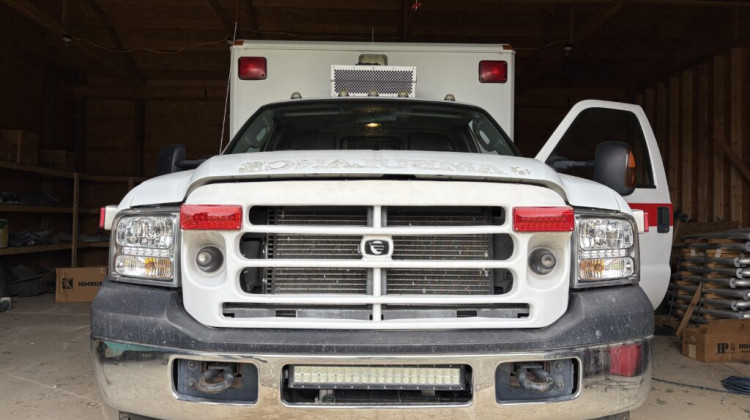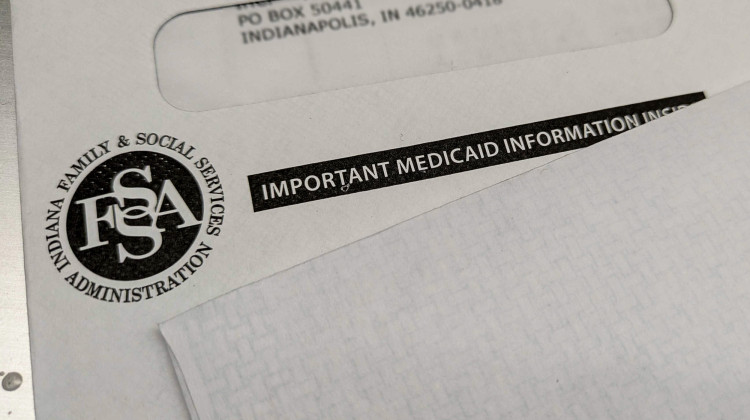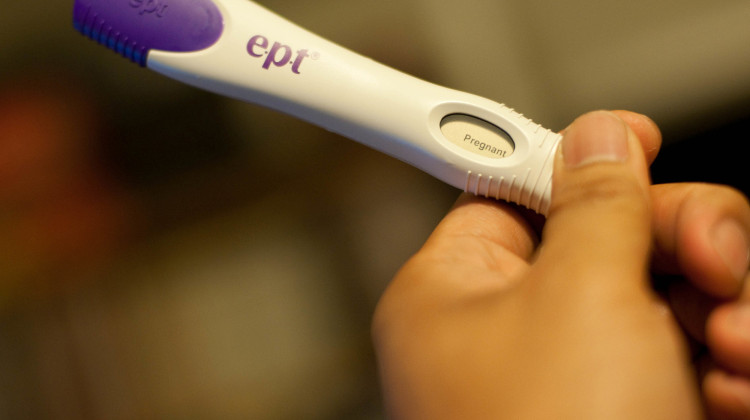
Margaret Mary Community Hospital CEO Tim Putnam stands outside the hospital's recently updated ambulance bay.
Carter Barrett (Side Effects Public Media)It's not uncommon for the emergency room doctor in a small, rural hospital to decide their patient needs care only available at a more advanced hospital — perhaps in Indianapolis, Cincinnati or Chicago.
However, transferring a critical patient is becoming increasingly difficult, according to hospital leaders, government officials and industry advocates. Patients are spending hours — or sometimes days — in that rural hospital emergency room waiting for an ambulance. A scenario that some are warning can be life or death.
“I mean, ultimately, it's going to lead to worse outcomes,” said Dr. Michael Kaufmann, Indiana’s EMS medical director. “So, higher morbidity and mortality for Hoosiers.”
It’s a problem being faced across Indiana — and other parts of the country.
Emergency medical technicians, paramedics and others who make up the emergency medical services industry are facing an increase in demand, while their pay is stagnant, experts say. At the same time, the expectations of EMTs are more demanding, and after an exhausting year, some are reexamining their career for better paying options.
Too Few Resources
On a hot July day, Margaret Mary Community Hospital CEO Tim Putnam stands outside the hospital in Batesville, Indiana — a rural community in eastern Indiana near the Ohio border. He gestures to the newly expanded emergency room, and jokes the next expansion will take over the neighboring golf course.
The hospital is a crucial lifeline here. It’s deemed “critical access” because the health care options in this region of the state are sparse.
“We could be the closest hospital for probably 30 miles,” Putnam said. “And a lot of those are not 30 miles of straight road. It takes a long, long time to get from some of the places people come from to here.”
Putnam is also an EMT. He’s worked in the field and witnessed the growing challenge hospitals face finding ambulances to transfer patients to another facility.
“You can't be in a really small community and just do 911 when you have people waiting hours in the emergency department to get transferred to a trauma center or a stroke center or cardiac center,” Putnam said.
In rural counties, the ambulance service answering 911 calls may have just one or two in-service ambulances. So when someone needs to be transferred from the county’s hospital to a distant metro area, the 911 operator can’t risk leaving the county understaffed.
In an effort to reduce risk for the county, Putnam’s hospital subsidizes the nearby Letts Community Volunteer Fire Department to assist with transfers.
Letts Community Volunteer Fire Department Chief Matt Morrow said the fire station recently added ambulances to help manage call volume for the primary 911 service.
He says it’s normal for EMS providers to work multiple jobs — which he believes more people are cutting back on — or receive additional training to become nurses.
“I have never taken care of as sick of people as what I've taken out of hospitals to go on to bigger facilities,” Morrow said.
The partnership between Margaret Mary Community Hospital and the volunteer fire department is one example how emergency providers can help supplement the local 911 service.
But in other parts of Indiana, there isn’t always a volunteer or private ambulance service available to step in.
Twenty miles north at Rush Memorial Hospital in the small city of Rushville, leaders have tried to hire EMTs to exclusively handle transfers but struggled to fill the open positions.
“And so when a patient comes in and needs a higher level of care, it has never up until recently been so scary,” said Carrie Tressler, the hospital’s vice president of nursing.
Tressler, who has worked as an emergency room nurse for 30 years, said they often struggle to find transfer services for patients.
“The nurses, you know, spend a lot of time on the phone, trying to call outside services to see if they're willing to help us out.”
In the worst-case scenario, Rush Memorial Hospital can call a helicopter but for mid-level care patients it’s trickier. Tressler said psychiatric patients can wait days to be transferred to another hospital.
Increasing Demand, Same Pay
The pandemic year of 2020 saw the highest volume of 911 calls on record, according to the Indiana Department of Homeland Security. This is an increase from approximately 750,000 calls in 2018 to more than 1 million last year. The first half of 2021 is on pace to continue the uptick in demand, which DHS officials say is not exclusively related to COVID-19.
And while the EMS workforce has trended downwards, expectations from hospitals and the government of EMTs and paramedics has grown.
“The health care that's delivered by an EMS provider has evolved dramatically,” Kaufmann said. “The amount of training, the amount of experience, the skills that are necessary to have a well-trained EMS provider has really increased.”
But the wages for these highly trained first responders have not.
“Costs have increased dramatically for EMS agencies — cost of pharmaceuticals, cost of gasoline and cost of personnel because of the lack of personnel,” said Nate Metz, president of the Indiana EMS Association. “There's now a wage war going on with the EMS providers and costs are increasing dramatically.”
In Indiana, the median hourly wage for an EMT or paramedic is $16 an hour.
And for some EMTs, there are better paying, less stressful jobs outside of health care, such as working at an Amazon warehouse or even operating a food truck for kids.
“My EMTs can work serving snow cones, blueberry snow cones, for more money than what they do as an EMT,” Metz said. “But if I pay my EMTs more, I'm going to go bankrupt.”
The Reimbursement Dilemma
A reason EMS providers aren’t paid more: an outdated payment system.
Traditionally, EMS is only reimbursed for transporting a patient to the hospital. Industry advocates say there are other long-standing issues with reimbursement from Medicare and Medicaid not covering the cost of running an ambulance service — like being on call 24 hours per day, everyday or providing on-site care.
“The amount that is paid to the ambulance service for the care and transportation ... falls far short of the actual cost of operating the service,” said Dia Gainor, executive director of the National Association of State EMS Officials.
Medicare and Medicaid are government-run insurance programs that serve low-income, elderly and disabled Americans. For many years, EMS was considered more of a transportation service than a medical service. But reimbursement largely has not evolved to meet modern expectations of EMS.

On the federal level, the American Rescue Plan allowed ambulances to be reimbursed for treatment-in-place — or medical care provided in a patient’s home — during the extent of the COVID-19 public health emergency.
Advocates say making this reimbursement change permanent would be an important step forward.
Morrow, the small town volunteer fire chief, said he struggles “to pay our people what they're worth because of reimbursement for Medicare, Medicaid, and private insurance.”
There have been improvements in Medicare and Medicaid reimbursement — especially at the state level in Indiana — but industry advocates are pushing for more.
“So as gas increases, as health care costs increase, as wages rise, ambulance services don't have an ability to kind of increase their reimbursement to reflect those, those higher costs,” said Tristan North, who oversees Government Affairs at the American Ambulance Association. “So it really hasn't kind of kept up with the times.”
Many industry leaders are hopeful pandemic-era changes to the Medicaid reimbursement process will become permanent.
Life And Death Stakes
The consequences of waiting hours or even days to be transported to a more advanced medical center can be dire, according to hospital leaders, government officials and industry experts.
Metz, the Indiana EMS association president, said lives are at stake.
“There are hospitals in the state right now that are waiting eight, nine, 10 hours to get a transport to take that patient to a higher level of care,” Metz said.
Metz said he is frustrated with the lack of a legislative response to their calls for help and warned that ambulance response times are growing longer.
“Even our association has been, you know, raising this alarm now for eight years, and no one wants to listen,” Metz said. “Last legislative cycle, we've raised this alarm, trying to push legislation to help us. No one wanted to listen, none of it got passed, it all got shut down.”
This story was produced by WFYI’s Side Effects Public Media, a news collaborative covering public health. Contact Side Effects reporter Carter Barrett at cbarrett@wfyi.org. Follow on Twitter: @carter_barrett.
 DONATE
DONATE





 View More Articles
View More Articles



 Support WFYI. We can't do it without you.
Support WFYI. We can't do it without you.